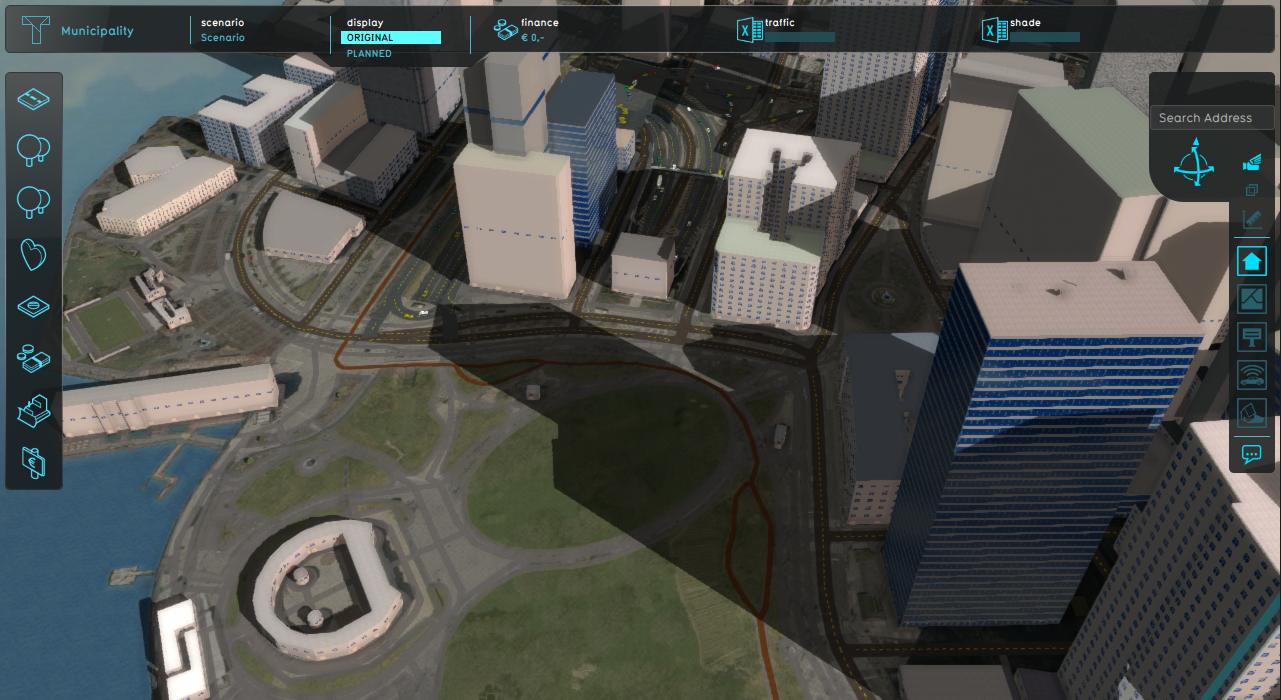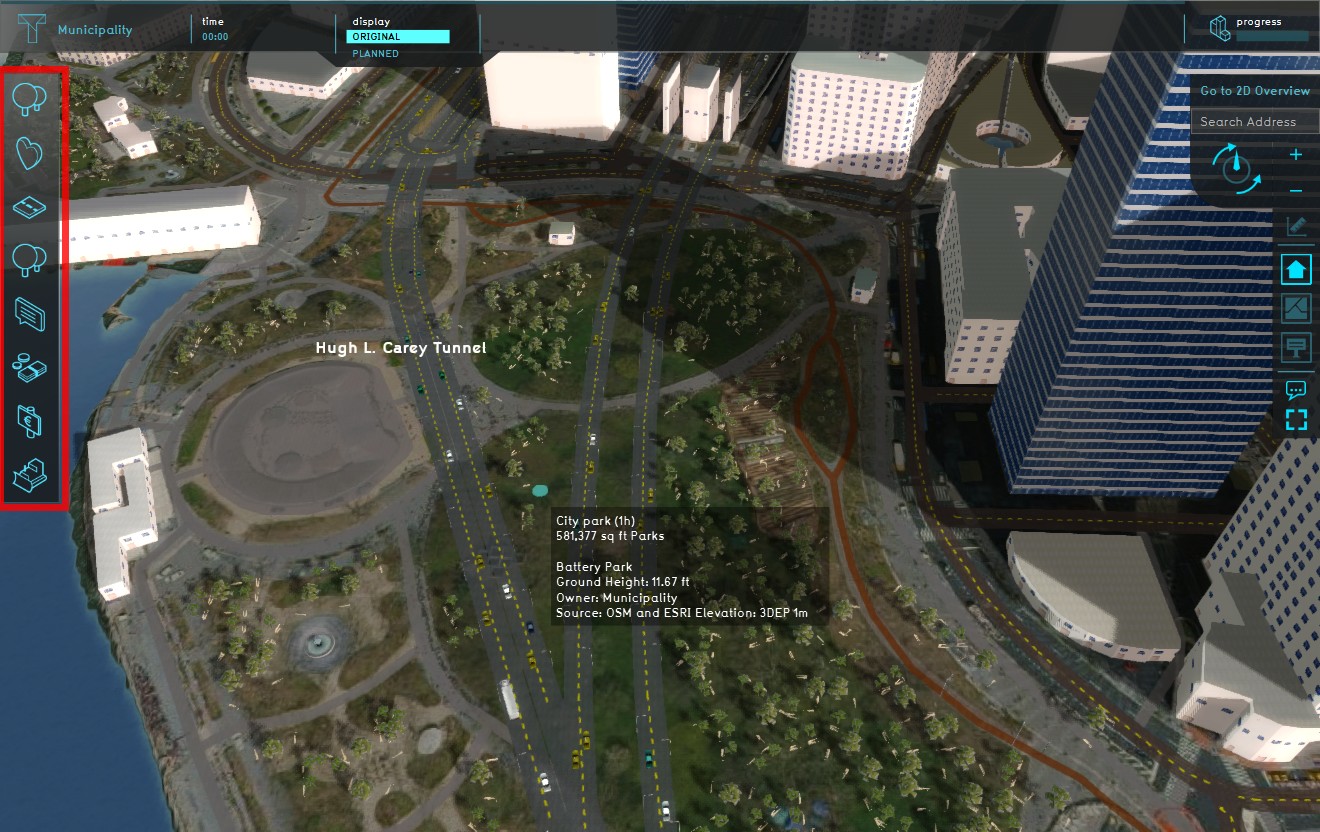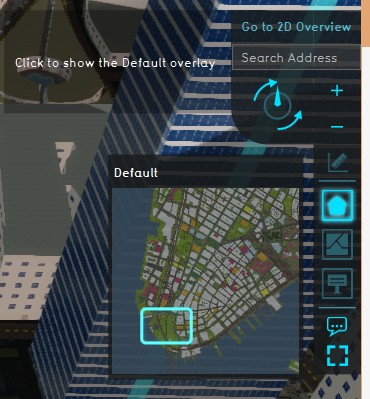Tygron Client: Difference between revisions
No edit summary |
No edit summary |
||
| Line 30: | Line 30: | ||
===Options=== | ===Options=== | ||
: ''Main article: [[Options interface]]'' | : ''Main article: [[Options interface]].'' | ||
The options interface is used for the screens where you are able to manage your games and accounts. They can be found under the option "Options" in the main menu. They are screens comprised of lists of that which you wish to manage, and several input fields for their properties. By using the buttons and input fields, you can change the properties of users and games. | The options interface is used for the screens where you are able to manage your games and accounts. They can be found under the option "Options" in the main menu. They are screens comprised of lists of that which you wish to manage, and several input fields for their properties. By using the buttons and input fields, you can change the properties of users and games. | ||
===Game=== | ===Game=== | ||
: ''Main article: [[Game interface]]'' | : ''Main article: [[Game interface]].'' | ||
[[File:Interface_game_general.jpg|400px|right|The game interface.]] | [[File:Interface_game_general.jpg|400px|right|The game interface.]] | ||
The game interface is the most complex interface in the Tygron Engine. During the game, the 3D World is largest visible element on the screen. Near the edges of the screen you can find the most prominent parts of the interface. These are used to provide information to the player, provide means to the player to gather more information, and to interact with the 3D world. | The game interface is the most complex interface in the Tygron Engine. During the game, the 3D World is largest visible element on the screen. Near the edges of the screen you can find the most prominent parts of the interface. These are used to provide information to the player, provide means to the player to gather more information, and to interact with the 3D world. | ||
| Line 78: | Line 78: | ||
===Multiplayer=== | ===Multiplayer=== | ||
: ''Main article: [[Multiplayer interface]]'' | : ''Main article: [[Multiplayer interface]].'' | ||
===Editor=== | ===Editor=== | ||
: ''Main article: [[Editor]]'' | : ''Main article: [[Editor]].'' | ||
Revision as of 08:00, 27 August 2014
Interface
An interface is an intermediary by which two systems, such as a human and a machine, communicate. An interface serves as a means to retrieve and provide information in a way the other system is capable of providing or understanding.
How interfaces are implemented in the Tygron Engine
Each part of the Tygron Engine which can be accessed, can be accessed by using a graphical user interface. This means that options are provided by listing them in the form of texts or icons, and you can select these options using your cursor. Because the Tygron Engine encompasses several different functions, the Tygron Engine also uses different interfaces to allow you to interact with it.
Types of interface
There are 5 different types of interface which may be available as you use the Tygron Engine.
- Main menu
- The login screen and initial menu. In the main menu, you can select which functionality of the Tygron Engine you wish to use (whether you wish to edit a game, play a game or manage your games and accounts.
- Management
- The management screens. To manage your games and accounts, you can use the management screens. In these screens, you will be able to use simple lists and buttons to indicate what you wish to do.
- Game
- The interface during the game. This interface is overlaid over the 3D World, and provides a player with all the options and information relevant to their stakeholder. This is the most complex interface.
- Multiplayer
- The multiplayer administration application. This is a simple interface used to control multiplayer sessions. All options are organized in tabs.
- Editor
- The interface used to edit a game. Part of the interface includes a panel with a view of the 3D World with the game interface. The editor interface is structured around the 3D World panel.
How to use the interfaces
Although each interface follows standard practices for software interfaces, it can sometimes be a bit daunting when an interface changes. This is why descriptions for the interfaces are available.
The main menu Is the first visible interface. It is first seen when starting the Tygron Engine in the form of a login screen. When you have logged in successfully, the main menu will appear on the left of the screen. Each option has a clickable icon, and is located in a descriptive section with a title at the top. When an icon is clicked, you progress further into the menu. When your options have clearly indicated what you wish to do, you will proceed into a different part of the editor. For example, you can follow the steps below to start the editor, and enter a different part of the Tygron Engine with a different interface:
- Go to engine.tygron.com.
- If presented with a log in screen, enter a valid username and password, and log in.
- Under the heading "Editor", select "Start Editor".
- Select "New Project".
Options
- Main article: Options interface.
The options interface is used for the screens where you are able to manage your games and accounts. They can be found under the option "Options" in the main menu. They are screens comprised of lists of that which you wish to manage, and several input fields for their properties. By using the buttons and input fields, you can change the properties of users and games.
Game
- Main article: Game interface.
The game interface is the most complex interface in the Tygron Engine. During the game, the 3D World is largest visible element on the screen. Near the edges of the screen you can find the most prominent parts of the interface. These are used to provide information to the player, provide means to the player to gather more information, and to interact with the 3D world.
The game interface consists of multiple important and prominently available panels, as well as a number of minor interface elements.
Top bar
The top bar is the large element at the top of the interface. Displayed, in order from left to right, are the Tygron logo, the stakeholder name, the time, the display mode, and the indicators. When the Tygron logo is pressed, the credits of the game are displayed. The stakeholder name indicates which role the player has selected, and thus which party they represent in the game. They can click the name of the stakeholder to view descriptions of other stakeholders. The time indicates how long the game has been running so far. The display mode allows you to switch between seeing the 3D world as it currently is and how it was at the start of the game.
The right section of the top bar is entirely filled with indicators. Starting with the budget indicator and ending with the progress indicator. Each indicator shows the current amount of progress made on that indicator towards the target set for it. By hovering over the indicators, you can see the full name of the indicator, the current score on the indicator, and the importance of this indicator for your total score.
Category panel
The category panel is the list of icons on the left hand side of the screen. This panel contains the actions you are able to take during the game. By clicking on one of the icons, you open the action panel. In the action panel you can select a specific action.
Action panel
If it's a measure without a spatial element, you will simple be able to "apply" or "cancel" the action. If it's an action with configurable settings (such as the amount of floors for a building), an element will be provided to allow you to select a proper value.
If you need to indicate in the 3D World where to take the action, you can use the cursor to "draw" a selection on the game area. This is done by pointing the cursor at the game area, holding down the left mouse button, and releasing the mousebutton. Making a selection is subject to validity. For more information on validity, please see Drawing validity.
Minimap
The minimap is the nearly square panel at the top right of the screen. It is a small representation of the game area. The light blue rectangle on the minimap indicates where you are currently looking at. The text at the top of the minimap panel is the name of the zone you are looking at.
The most important function of the minimap is to allow you to navigate the game area quickly. When you click anywhere on the minimap, you are immediately brought to the location on which you clicked. When you or another player take an action which requires your attention, an exclamation mark icon will appear on the minimap. Clicking on an exclamation mark icon will immediately move you to the area in question, and also open up the popup at that location.
Located at the bottom of the minimap are buttons which allow you to switch overlay. By switching to a different overlay, the 3D World is colored differently to provide you with additional information.
You can also use the minimap to signal a location to other players. This is known as "pinging". By clicking on the ping button at the top right corner of the minimap panel, the minimap of all other players will show your location via a pulsing circle. You can use this to indicate to another player a specific location in the game area.
Popups
Popups are an important part of the interface, that are not immediately visible to the player. Instead, they appear whenever an action is taken, and input is required from the player concerning that action. This includes actions which the player takes themselves, but popups more often appear when other players take actions which the player in question must respond to. They also appear in the minimap in the form of exclamation marks.
Minor interface elements
Besides the major interface elements described above, there are also a number of smaller elements in the interface. These will appear and disappear depending on your interaction with the game.
Legend
When drawing in the 3D World, or using an overlay other than the default overlay, a legend will be displayed at the bottom of the screen. Drawing in the world or activating an overlay will cause part or all of the world to be colored. The legend serves as a reference for which colors correspond to what information. For example, when viewing the ownership overlay, the legend will display which stakeholder is displayed with which color. When viewing the livability overlay, it provides a reminder of which colors indicate the most and least desirable values.
Hover panel
When you hold the cursor still over any part of the game area, the hover panel will appear. The hover panel will display information about the area your cursor is pointing at, based on which overlay is currently active. By default, it displays the owner of an area, along with the type of terrain and construction located there. When, for example, the zoning overlay is active, it displays how much of each permitted type of construction is located in the indicated zone.
Multiplayer
- Main article: Multiplayer interface.
Editor
- Main article: Editor.


